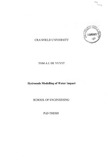JavaScript is disabled for your browser. Some features of this site may not work without it.
| dc.contributor.advisor | Vignjevic, Rade | |
| dc.contributor.author | De Vuyst, Tom | |
| dc.date.accessioned | 2019-10-10T11:29:48Z | |
| dc.date.available | 2019-10-10T11:29:48Z | |
| dc.date.issued | 2003-03 | |
| dc.identifier.uri | http://dspace.lib.cranfield.ac.uk/handle/1826/14606 | |
| dc.description.abstract | This thesis addresses the problem of hydrocode modelling of water impact. Two facets that are of importance when numerically modelling the impact of metallic structures on water are metal anisotropy and water behaviour during impact. In order to be able to take account of these effects in a hydrocode simulation an SPH solver has been incorporated into LLNL-DYNA3D. The treatment of contact in meshless methods has been addressed through the development of a contact algorithm which does not require the construction of surfaces. The interaction of finite elements and SPH particles is accounted for by using a novel approach in treating the finite element nodes as particles in the contact treatment. The same contact algorithm developed for the treatment of contact in the SPH method has been used. In order to take account of metal anisotropy a material model that takes account of anisotropy in the elastic and plastic regimes, strain-rate dependency and non-linear behaviour at high pressures including spall failure was developed. The developed simulation tool is validated against experimental data for the case of water impact of rigid cylinders on water. Further validation is achieved by demonstrating that the simulation tool can be used to analyse the crash behaviour of subfloor designs on water. This was achieved by simulating the impact on water of a structure representative of an aircraft subfloor. The effect of material anisotropy, skin thickness and skin failure on the structural response was demonstrated. A first step in extending the coupled FE-SPH modelling beyond fluid-structure interaction problems has been the development and validation of an explicit time integration ID Lagrangian kernel SPH code which in combination with an algorithm to track crack propagation would make the simulation of dynamic brittle fracture problems possible. | en_UK |
| dc.language.iso | en | en_UK |
| dc.rights | © Cranfield University, 2015. All rights reserved. No part of this publication may be reproduced without the written permission of the copyright holder. | |
| dc.title | Hydrocode modelling of water impact | en_UK |
| dc.type | Thesis | en_UK |
